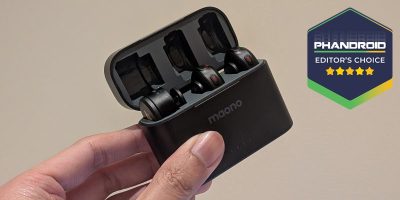These days, Chromebooks are a dime a dozen. They’re largely regarded as a cheap alternative to Windows laptops or the perfect starter device for students who are relying more and more on technology in the classroom. Google’s previous Pixelbook-branded Chromebooks have largely been aspirational devices, intended to show its partners what a top-of-the-line Chromebook should offer, but with the new Pixelbook Go, Google’s taking a bit of a different approach.
The Pixelbook Go is Google’s first Chromebook for the masses, not an experimental device intended for tech enthusiasts and those interested more in depleting their bank accounts simply to get the best hardware money can buy. Naturally, that means you’re not going to be getting a fancy hinge that allows the screen to flip all the way around so that the laptop transforms into a tablet or a separate screen and keyboard setup like last year’s Pixel Slate.
As we’ve seen, Chromebooks work best as laptops and the Pixelbook Go is one of the best laptops we’ve used in recent years.
The model Google sent over costs $850 and comes with an Intel Core i5 processor with 8GB of RAM, 128GB of storage and a 13.3-inch 1080p display. It can be configured as low as $650 or all the way up to $1,400. I’m not sure who would want to spend that much money on a device running on Chrome OS, but if you do max it out, you’ll get a 4K display, 16GB of RAM and 256GB of storage.
Needless to say, the specs you get are pretty standard for devices within the Pixelbook Go’s price range. What makes the Pixelbook Go special is its keyboard, the build quality, and its amazing battery life.
From a build perspective, the laptop looks and feels like it can compete with its Windows-powered counterparts. The laptop is built from magnesium, cutting down its overall weight to 2 pounds while still keeping it extremely rigid. Rather than expose the metal frame, Google chose to coat it in a soft-touch paint which makes it feel like a high-end plastic, but you won’t hear any creaking in the frame, even if you try.
The 1080p touchscreen display is bright enough to be used in direct sunlight, something we’ve struggled to do with many Chromebooks. Viewing angles and color reproduction aren’t spectacular. For that you’ll need to upgrade to the 4K model. Unfortunately, the 16:9 aspect ratio means you get pretty large bezels above and below the display. Going with a 3:2 display would have provided a bit more space for browsing the web and getting work done which is exactly what this laptop was built for.
The display hinge is tight enough to keep the panel from wobbling while typing. Typically this means you’ll have a hard time opening the laptop with one hand, but the rubber ribs on the bottom of the Pixelbook Go keep it from sliding around on nearly any surface. Users will find two USB C ports on the laptop, one on each side and Google was kind enough to retain the 3.5mm headphone jack for those who prefer a wired audio experience rather than Bluetooth. Google’s also included a 1080p webcam that is used for snapping 2.1MP photos or for video calls. The quality of the image is laughable when compared to even a bad smartphone selfie camera, but low light performance is better than what we’ve seen from webcams on other Chromebooks and of course it’s a step up from the 720p offering on even the highest-end MacBooks.
Google doesn’t have a lot of experience when it comes to building laptops, but it has somehow managed to build one of the best keyboards we’ve ever used. The keys offer just the right amount of travel with a satisfying click when pressed. Google’s marketing the keyboard as having “Hush keys” which are quite a bit quieter than any other Chromebook we’ve tested. Of course, no keyboard is perfect and in the case of the Pixelbook Go, the lack of a delete key is baffling and substituting the caps lock key in favor of a launcher key is completely unnecessary.
The trackpad is pretty good as well, giving users ample space to work with and for using Chrome OS’ multi-finger gestures. That being said, we’re not huge fans of the loud click when pressed. It’s obvious that the engineers at Google didn’t spend nearly as much time on the trackpad as they did on the keyboard.
Battery life is also one of the highlights of the Pixelbook Go. Google claims that the included 47Wh battery should deliver 12 hours of mixed-use. In our testing, we averaged 12 hours and 11 minutes per charge which is much longer than what you’ll get from most Chromebooks and even Windows laptops these days. Naturally, those times dipped a bit when we spent a few hours playing Android games or using the webcam for a video call, but you’ll still be able to get at least 9-10 hours of run time out of this device even when you’re pushing it hard.
If you do manage to run down the battery enough to warrant a charge, the included fast charger will give you two hours of run-time with a 20-minute charge or top off the battery completely in just under 2 hours.
Those who have never used a Chrome OS device before should have no issues jumping in and getting started. Compared to Windows and macOS, Google’s operating system is pretty minimal. The Chrome browser is the main workhorse since most everything we do these days is on the web, but users also have access to thousands of Android apps that can be installed through the Play Store.
While I didn’t encounter any issues running any of the Android apps I installed, there are still quite a few apps like Netflix and Instagram that don’t support window resizing. These apps take up the full screen and can’t be used side-by-side with other apps. It’s not a huge deal, but it’s something app developers should have resolved a while ago since Android apps on Chrome OS have been around for over two years now.
Unfortunately, Chrome OS still isn’t an operating system for everyone. Even with its new dedicated file manager and a wide selection of apps through the Play Store, the platform is still a hard sell for those who want to build websites, create art or make videos. Sure, there are great Android apps like PowerDirector, but they simply can’t compete with what’s built natively for Windows and macOS.
This brings up the question: who is the Pixelbook GO made for? If all you need is a web browser to surf the web, there are plenty of cheaper devices out there. The $650 entry price point for these laptops is more than the average Chromebook, but the hardware you get is definitely worth every penny, especially for those who value battery life and build quality over all else. There’s honestly no reason to go above the $850 mark since we’re not sure why anyone would need a higher resolution display, 16GB of RAM or more than 128GB of storage in a Chromebook.
The hardware Google has put together for the Pixelbook Go can definitely go head-to-head with the best laptops that are out there, but Google still has some things to sort out if it wants Chrome OS to graduate from the education to the consumer market.
Pixelbook Go Rating: star_full star_full star_full star_full star_empty(4.0/5)
The Good
- Amazing keyboard
- 12-hour battery life
- Impeccable build quality
The Bad
- Expensive
- Chrome OS has its limitation
- Major Android App’s are still not optimized
The Bottom Line
If you’re looking for the best Chromebook money can buy, the Pixelbook Go is a great option. That being said, most people will be better served by a cheaper Chromebook alternative or a Windows laptop if they need more than what Chrome OS has to offer.











Comments